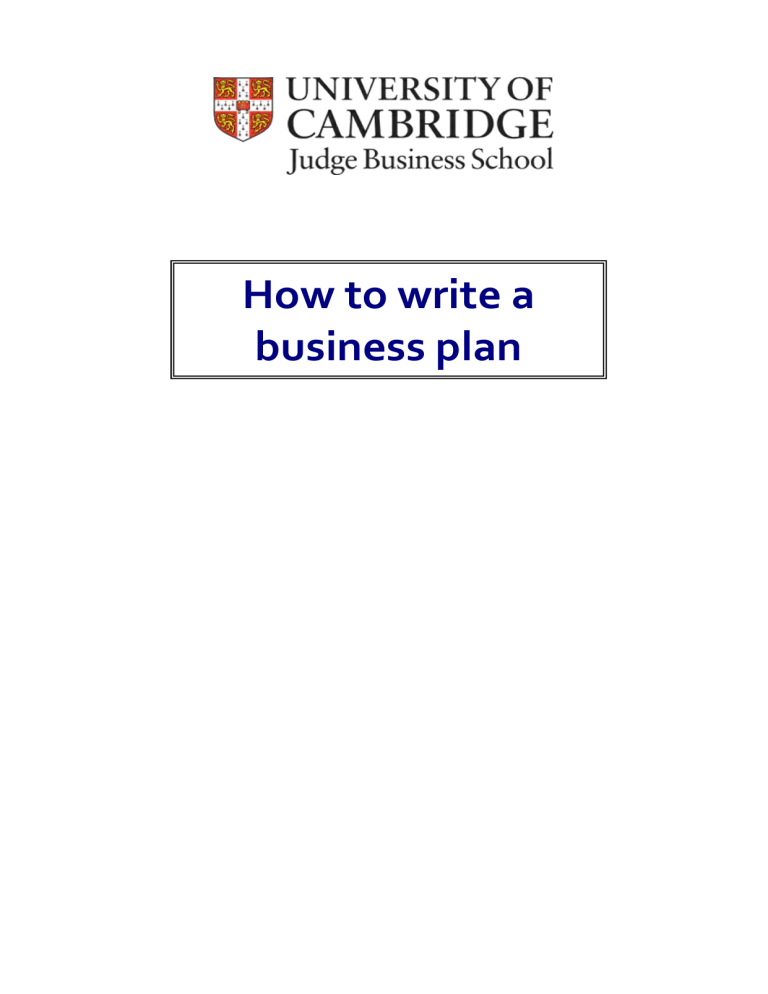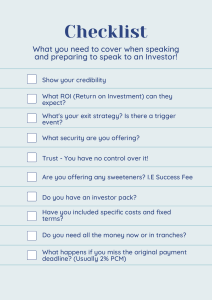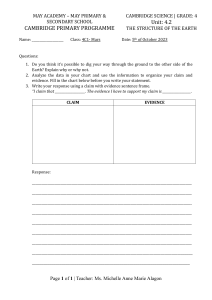
How to write a business plan Accelerate Cambridge October 2013 HOW TO WRITE A BUSINESS PLAN The purpose of this note is three-fold: To provide a set of guidelines on how to write a business plan. To highlight what a prospective investor or banker is, and is not, looking for in such a plan. To provide a summary check list of the attributes of good business plans. The note does not provide a magic formula to be followed. Indeed, business plans produced to a set formula (such as those produced using business planning software) lack authenticity and credibility. Ideally, the business plan should be your plan, conveying the distinctive character both of the venture and its proponents. That is why you should retain overall responsibility for writing it, not somebody else. By all means seek help with the plan but do not commission someone else to write the whole thing for you. Use this note as your guide or aide memoir. The Purpose of a Business Plan Any business plan has a dual function: 1. Internal: Providing management and staff with a clear map, complete with signposts and milestones against which progress can be monitored and evaluated. 2. External: Presenting the investment case to an outsider. This key function provides the focus for this note. Essentially, business plans are sales documents. What they are selling is your business idea, your product or service and, above all, you and your track record. But in selling these things you are also competing. Figures from the venture capital industry indicate that roughly 85% of all business plans are rejected almost at once, 15% are given serious consideration but only 5% reach the negotiating stage. Your target is that final 5%. As with any sale, you should start by asking yourself: Who is my target customer? Banker, venture capitalist, private investor or a prospective family backer? What are my customers’ needs? Return on investment and eventual exit option for a venture capitalist, security for a banker, etc? What exactly am I selling? Equity, a business opportunity, a license? What do I want from my customer? Equity, loan (secured or unsecured), expertise or advice? The business plan is your sales tool. Make sure that you know what you are using this tool for and take time to develop it. Page 2 of 11 Accelerate Cambridge October 2013 The Business Plan Framework Your plan should encompass the following issues: 1. 2. 3. 4. 5. 6. 7. 8. 9. Summary. Brief history The product or service. Markets and competitors. Marketing plan. Production and operations. Management and is objectives. Finance. Risk, return and exit. 1. Summary: This is the one page that you can be certain will be read. It is, therefore, your best opportunity to capture the reader’s imagination and interest, persuading him that it’s worth reading on. Start with a cogent and concise one sentence statement of the business idea. A sentence that is so clear and appealing that the reader can immediately visualise or ‘see’ the business. You can then go on to describe: The market at which you are aiming. The specific benefits offered by your product or service. The unique features or factors that enhance the chances of success. The competence of the management team. The stage that the business idea has reached. The financial requirements, the specific purposes to which the finance will be put and the dates at which it will be needed. The potential risks and return. Keep the summary to one page. Write it last and keep working at it until you are sure that it gives your reader a crystal clear picture of what the business is, why it should succeed, what he can do to help and what reward he should expect in return. Remember, that as he reads it your prospective investor will be thinking: What’s the potential scale of this business? Is the idea really sound? How strong is the team? What’s the risk and return? Page 3 of 11 Accelerate Cambridge October 2013 2. History: Again provide a succinct summary of (a) the stage that your venture has now reached and (b) the progress that has already been made; e.g. test market executed, product development completed, equity finance committed from other sources, recent trading history. In other words, the short history section should answer the question: where are we now and what have we already achieved? 3. Product or Service The summary began with a one sentence definition of the business idea. Now it can be expanded and developed. Try to provide the following: A precise description of what the product or service is and what it will be used for. A realistic assessment of your product’s unique or distinctive advantages and the way in which these advantages will translate into benefits for your customers. An evaluation of the ease with which competitors might imitate your advantages and match your benefits, plus quantification of these benefits if possible; e.g. customers’ financial gain via lower price, lower maintenance costs etc. A simple, but not simplistic, analysis of the technology you are using and an appraisal of the risks associated with it. When discussing technical issues, remember that your understanding of these will almost certainly be incomparably greater than your reader’s and that there is nothing more off-putting than reading a technical explanation that has been written by someone who is completely infatuated with the technology. Keep the description clear, use illustrations and confine technical details to an appendix. Finally, if the product is highly technical do not conceal any technical difficulties. These are bound to be exposed and you will lose credibility if this is done by the investor – or his technical advisor. Page 4 of 11 Accelerate Cambridge October 2013 4. Market and Competitors Market Having ‘sold’ your product you must now demonstrate that a genuine market exists, with opportunities that you can exploit. You might proceed in two stages. 1) A general description of the market covering: Its estimated size and composition, including geographical spread and major customer types. Recent history and likely future developments: growing, static etc. The ways in which the market operates and the principal axes of competition: price, quality, service, reputation. This general description simply forms a backdrop to Stage 2 of your market analysis. 2) An analysis of your target market segment. Explain how the overall market is segmented and identify the segments at which you aiming. What the reader needs to know is: Where the segments are: local, regional, national or international. Their relative size and rates of growth. Particular characteristics, notably consumer buying patterns and priorities. The market analysis will underpin all subsequent estimates of future sales and it forms therefore the lynchpin of much of the financial information to be presented later in the plan. So try to ensure that: Market opportunities are realistically evaluated and, where possible, supported by quantitative data; e.g. number of potential customers, target market share. You exhibit a good qualitative understanding of how the market works, what your customers want, how you can reach them and what adjustments they may have to make to support your product or service. Competitors Good competitor analysis is crucial. Try to address the following questions. Who are my potential competitors, how large are they and how are they organised? On what basis do my rivals compete: price, sales volume, reputation, product design, quality, reliability, service? How does my product compare with those already available in terms of price, performance, reliability and so forth? Page 5 of 11 Accelerate Cambridge October 2013 What makes the product superior or different and how can I protect its unique features from imitation? What barriers does a new entrant face and how is the competition likely to react to my entrance into the market? Will they retaliate and, if so, how? Will others follow my lead? In what areas are my competitors demonstrably competent? Where are they vulnerable and how can I exploit this? How do my potential customers see the competition? Competitor analysis can yield a wealth of information. Your plan should summarise this and demonstrate that you have a clear understanding of how the competitive game is played. 5. Reaching the market You have described the market, identified your target segment and analysed the competition; now you need to show how you will reach the market. Winning 1% of a large market sounds very little but without clear evidence of how exactly you will get 1%, the target is fanciful. To translate the target into reality you need to formulate a strategy on: 1) Pricing. What is the target price, how is it set (cost plus or demand based), how does it compare and what margin does it give you? If the target price differs markedly from prevailing prices explain why this is so; e.g. different cost structure, superior features etc. Bear in mind that one of the most common faults of any new business is under pricing, thereby squeezing the margin from the outset. 2) Promotion. In the early years promotion expenditure can be a major drain on a new business, with money often being spent because of the vague feeling that “we ought to be spending something on promotion”. ‘Ought’ is an insufficient reason to spend anything. Think carefully about: What you want to achieve through promotion. How you might do this without spending money (e.g. via editorial coverage in the trade press, not advertising). What the mix of promotion should be; advertising, direct mail, attendance at trade fairs. Hint – avoid using a ‘shotgun’ approach to promotion, it will lose you credibility with potential investors. How this mix relates to the ways in which your customers operate. Page 6 of 11 Accelerate Cambridge October 2013 3) Selling and Distribution The questions here are relatively straightforward, although often neglected: What distribution channels exist? Which of these will you use: direct sales force, agents, freelance commission reps, selling by the management team itself? What is the proposed geographical coverage of your sales force, how big will it be, how will it be remunerated and how productive do you expect the reps to be: number of calls, conversion of calls into sales and average sales per call? The business plan is not the place to develop a full blown marketing plan. Explain what the marketing strategy is and why you believe it will succeed. 6. Production and Operations As with the product description, the main danger here is that of an excessively detailed and technical description of the processes involved in producing your product or delivering your service. Keep it simple and accessible. Focus on key issues, such as: Your sources of supply and degree of dependence on any single resource; e.g. skilled labour or one type of raw material. Particular problems associated with supplies; e.g. long lead times, dependence on one supplier, availability of alternative, back-up sources. How you will manufacture your product and how the production process operates. Focus specifically on those key processes that you are still developing and those critical production stages at which problems might occur. The proposed split between manufacturing in-house and using outside, sub-contractors; anticipated shifts in this – e.g. as production expands or moves in-house. The nature of the plant and machinery to be used and the financing requirements associated with this. Do you intend leasing or buying equipment and at what cost? Estimated manufacturing costs. It is essential that you understand fully what these are and how they will be controlled or reduced. The particular experience and competence of the management team to manage the production process. Requirements in terms of premises; use, location, type, size, cost and expansion potential. Quality: how will this be monitored, particularly as output increases, and what are the costs/benefits of your quality control strategy? Finally, what stage has production reached: design, prototype, pre-production? How will you manage the smooth transition form producing a prototype to producing in volume? Not all aspects of the production process will be equally critical. Focus on those that are, show that you understand where problems may occur and that you have a strategy for dealing with these. Page 7 of 11 Accelerate Cambridge October 2013 7. Management Would you back a horse, irrespective of its jockey, or back a good jockey irrespective of his mount? Ideally, you would like a good combination of both but, if forced to choose, many people would put money on the jockey rather than on the horse. So, too, with investors. Ultimately people have priority over products and that is where the money goes. Your analysis of management and its objectives is therefore critical. You should try to provide the following: Summary of who the owners/directors are and the degree of their control over the company. Evidence that the assembled team has the track record, experience and expertise to achieve its goals (put detailed CVs in an appendix). Confirmation that the interests and competence of the team members are complementary. Projects that stand or fall on one person, or those that represent the coming together of like minded individuals (e.g. a group all sharing a common technical background), ring alarms bells. If you have yet to assemble the team then describe what you are looking for and how you will achieve the right balance between team members. Analysis of expected future staffing needs, plus an assessment of where you will find good people, how you will organise and keep them. That’s the team, but your investor will also want to know something about its objectives. Think about these questions: What do you and your colleagues want out of the business? How ambitious are you for the business itself and what do you want it to become? How do these objectives compare with other businesses in the same industry? What are your investor’s needs and objectives? Formulating precise answers may be difficult. But where you can be specific is in spelling out the milestones you’ve set and by which you will judge progress; e.g. the timetable for reaching a certain level of sales, launching a new product, recruiting the management team. Good jockeys know where they want to be at each stage in the race. Rarely do races or businesses go exactly to plan, but at least you should set out with a clear idea of where you are going, how quickly and with what anticipated reward at the finish. Page 8 of 11 Accelerate Cambridge October 2013 8. Finance Financial analysis is important but it is not the business plan. Spread sheets all too easily proliferate, obscuring the financial essentials. The purpose of the finance section is (a) to set out the financial implications of your strategy, (b) to provide a measure of performance and (c) to substantiate your financial requirements. Detailed financials data is best kept to an appendix comprising: sales forecast, profit and loss account, balance sheet, cash flow forecast, breakeven analysis. Ideally the period covered by the forecast should be 3 to 4 years; rarely will a forecast of less than 3 years suffice. Ensure that all financial data is self explanatory and not encumbered with endless notes. The plan itself should contain a narrative summary covering: Key assumptions underpinning your forecasts. Expected sales growth, year by year. Sensitivity of the forecast to any change in a significant variable: price, cost, sales volume etc. Cash flow, cash requirements and major items affecting this; e.g. credit control. Capital investment needs and the anticipated payback on this investment. Realistic and pessimistic scenarios in those areas where forecasting uncertainties are greatest: e.g. sales, cash flow Financial requirements, the purposes to which the finance will be put and estimated future needs, including the timing of these. Contingency allowances. In preparing this narrative summary it is important to remember that: Your figures will be compared with those prevailing elsewhere in the industry; they therefore need to be consistent with actual experience. The most common problem with business plans is over optimism and an unrealistic assessment of just how long it will take to achieve your goals. Leaving things out or disguising difficulties is short-sighted. Eventually they will emerge and you will lose credibility if it takes someone else to flush out omissions. Uncertainty pervades any plan and does not provide an adequate reason for not forecasting in the first place. Do your forecasts, but highlight key assumptions and areas of uncertainty. Page 9 of 11 Accelerate Cambridge October 2013 9. Risk, Return and Exit Sooner rather than later the prospective investor will ask himself: What is the risk, what sort of return can I expect for bearing this risk and how can I realise my investment, i.e. exit? There are two ways of tackling the first issue, that of risk. Either, address the risks associated with the proposal at each stage at which these occur, e.g. productions, sales, staffing etc… or, alternatively, conclude your plan with a separate section devoted specifically to risk and the related issues of return and exit. Whichever option you choose it is important that you are: realistic in appraising risks; neither selective nor over pessimistic about the difficulties; clear about how you intend minimising the risks; aware of potential objections to your proposals. Bear in mind that the investor’s objective is to maximise the investment gain, not exercise control over the business. What he needs to know is how valuable your company might become (and therefore what is the expected future value of the initial investment), and what routes are open to realising a capital gain. Summary Your business plan is, first and foremost, a sales tool. It is essential that it looks good and reads well. Professional presentation is critical. Beyond this you should observe the following guidelines: 1. The text should be cogent, concise and clearly laid out. 2. Focus on key issues, avoid extraneous details. Knowing what to leave out is just as important as knowing what to include. 3. State clearly what makes your product different or better and exactly where you intend focussing. Trying to do too much is indicative of a poor understanding of what you could do best. 4. Formulate objectives that are unambiguous, consistent, credible and compatible with industry experience. 5. Show that you really understand how your target market operates, what your customers want, how you will distinctively meet these needs and on what basis you will compete successfully. 6. Display a clear understanding of your investor’s needs and interests. 7. Avoid complete infatuation with your product and how it will be produced. 8. Demonstrate that the team you have assembled has the balance and the track record to exploit the market opportunity as well as the determination to stick with the venture. 9. Openly address risks and problems, explaining how you intend dealing with them. 10. Ensure that the plan is intelligible and complete in itself, having no need of additional data or explanation. Think also about how you could most compellingly sell your plan in a ten minute oral presentation. Page 10 of 11 Accelerate Cambridge October 2013 Finally, never lose sight of your audience. Remember that there may not be a single, homogeneous audience. Tailor your plan to meet the needs of your different audiences. Write your plan for a specific audience, not for yourself. Good luck! Page 11 of 11





